We slowly moved to higher ground, walking uphill and taking the occasional few steps. Suddenly there were only steps, going straight up, and it dawned on me that there was no wide staircase for climbing up to the Sigiriya Rock Fortress in Sri Lanka – also known as the Lion Rock Fortress. Only these steps alongside the rock.
Darn.
I visited the Sigiriya Rock Fortress in Sri Lanka in 2014 and have updated this post since.
Contents
Background information about Sigiriya Rock
Driving through the Matala District in Sri Lanka, an almost 200 meters high rock dominates the skyline. It’s Sigiriya, also known as the Lion Rock because of the giant lion claws that function as an entry gate about halfway up the rock.
An entry gate to what? Originally to the royal palace or the Sigiriya rock fortress at the top of Sigiriya rock.
The rock fortress of Sigiriya was built by King Kasyapa after he’d murdered his father, King Dhatusena, by plastering him into a wall, had seized the throne from his brother Mogallana, the rightful heir, and moved the capital to Sigiriya.
You can imagine he was worried about his brother seeking vengeance, but the battle didn’t take place as quickly as you’d suspect. Kasyapa had eleven years to enjoy his palace with a view until his brother finally laid siege to the rock. Knowing he’d lost, Kasyapa committed suicide. Mogallana took to the throne and moved the capital back to Anuradapura.
Lion Rock later became a monastery complex, but it was abandoned in the 14th century. Records show that it was used again by the Kingdom of Kandy in the 17th century and in the 19th century the site started getting attention by the Western world after British army Major Jonathan Forbes discovered it.
Today Sigiriya is a UNESCO World Heritage Site and one of the most visited historical places in Sri Lanka.
The Sigiriya Rock Fortress Climb
We were taken to Sigiriya by bus and dropped off near the entrance. Once we had our entrance tickets, we could freely roam the domain. There’s actually more to see at Sigiriya than just the lion rock fortress, as the rock is surrounded by pleasure gardens with man-made ponds. Remember, there used to be an entire city here.
Everybody immediately started climbing Sigiriya rock, though, and so I followed.
After passing through a long lane, we slowly started moving upwards. A few steps, then some “flat” ground, then a few steps again. All went well until, suddenly, there were only stairs in front of me. And they went up, way up. I hadn’t thought about this before, but the chances of the steps continuing within the rock so that I wouldn’t have to face the gazing abyss were pretty slim.
Darn.
I climbed the first round of steps and got to some sort of platform from where I had this great view over the surrounding area. Other people in my group took a photo and then quickly continues climbing Sigiriya Rock, while I stayed behind. I just kept photographing and filming the view, contemplating whether I should go on or not.
By then my fear of heights had kicked in and while I’d only had to take stone steps so far, the metal walking path constructed against the side of the rock didn’t really seem inviting to me. This monkey didn’t have any problems with it, though.
And this dog seemed pretty at ease as well.
Ashan, one of the guys from CVisit who was with us and who’d made this trip possible, encouraged me to go on. He told me I could skip the iron spiral staircase a few meters in front of us and just walk on along the Mirror Wall. Skipping the spiral staircase meant not seeing the frescoes, but as I was shaking already, I figured it would be best to just do as he suggested.
After I’d passed that metal runway you saw in the photo above, came the Mirror Wall. At first, it looks just like a wall alongside the rock that prevents you from seeing the view (good for me), but when I looked closer I was amazed at how smooth it was, just like marble. Ashan told me that this wall used to be so shiny that people could see themselves in it, hence the name Mirror Wall.
I gladly took in the facts he gave me on Sigiriya and tried to focus on them instead of on how high we were walking.
After the Mirror Wall, there were a few more hard (as in, I could see all the way down) steps to take, but with Ashan encouraging me to go I reached my goal: the Lion Gate. All that’s left now are the claws, but scientists believe that the lion sculpture used to be much larger, including a head and shoulders.
When you get there, you can climb that staircase all the way to the top. Now it may not seem high on my picture, but it’s 200 m or 656 ft. all the way up. Let me show you this photo I found on Flickr to give you a better idea of the dimensions:
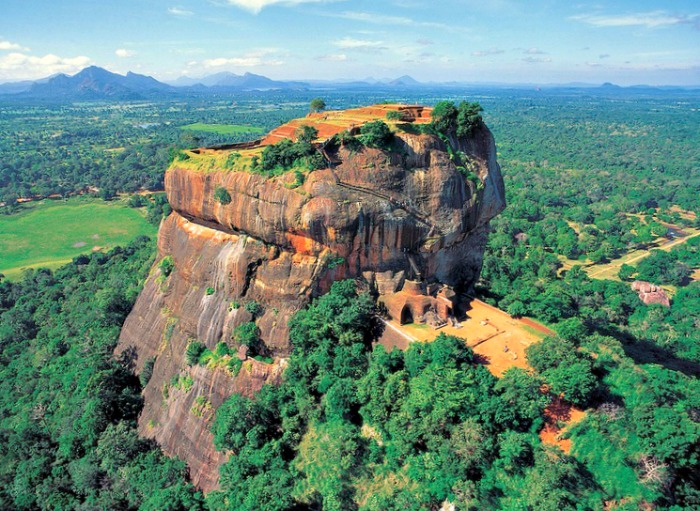
Source: Flickr – whl.travel
So we came along that path you see in the right middle of the photo and then climbed up to the lion gate, which you can see clearly. The platform where I stopped before that, the spiral staircase to the frescoes, and the Mirror Wall are left around the corner from the lion claws, on the part of the rock that you can’t see in the photo.
I can’t really tell you a lot about the top of Lion Rock, though, because I didn’t get there. No, that’s right, I didn’t. If it had been regular stone steps leading upwards I probably would have, but those iron steps that had gaps between each step so you could see the bottom… No, thank you. I have to admit I’m not brave enough for that.
One thing you should know: there are huge hornet nests along the side of the rock, not too far from the steps that take you to the top. Signs in Sigiriya urge people to be quiet and not provoke the hornets. They (the Sigiriya hornets, not the signs) fly out occasionally, and then you see people sitting down on the steps as the signs advise to keep low when it seems like the hornets are about to attack.
We spent some time by the lion gate before we headed back down. The route you take to go back down is a different one than the one to go up. I think that’s partially to only have one-way traffic on the sometimes narrow paths and stairs, but also to let visitors end up at the souvenir stores.
I didn’t mind. A couple of us bought ice cream there and even though I didn’t go all the way to the top, I felt like I’d deserved it.
Side note: don’t eat your ice cream in front of the monkeys. A vendor told me they’d snatch it away shamelessly if they could.
(You can also watch this video directly on YouTube)
Practical information for climbing Sigiriya Rock
How to reach Sigiriya
There are several ways to reach the Sigiriya rock fortress. The easiest one is of course by car. Alternatively, you can take the bus from any major city to Dambulla or Habarana. From both cities, you can take another bus to Sirigiya and the Lion Rock.
Another option is to take the train to Habarana and then the bus. And if you want to head to Sirigiya right after landing, you can take Cinnamon Air from Colombo International Airport to Sigiriya. The flight takes approximately 30 minutes.
If you’re staying in Dambulla, this Viator day-tour will get you there as well.
How many steps up Sigiriya rock?
There are 1,200 steps before you reach the Lion Rock fortress on top of Sigiriya rock, but that sounds harder than it is. There are several platforms that break up the steps and allow for a little break if you need it. From some places along the path you also get an amazing view of the surrounding area.
So 1,200 steps – how high is that? Sigiriya rock is 660 feet or almost 200 meters high.
How hard is it to climb Sigiriya rock? It’s super doable if you are in moderate to good shape. And even if you are in bad shape, you’ll make it up without any problems. when taking a few breaks along the way.
How long does it take to climb Sigiriya rock?
It really depends. If you’re in good shape and don’t stop to look at things, it’ll take you less than 30 minutes to climb all the way to the top of the rock. If you need a few breaks along the way or simply want to stop often to take photos and admire the view, it’ll take an hour and a half to two hours to climb up and go back down again.
It’s not a long, strenuous hike, though. You’ll spend more time looking around and taking photos than you will actually be climbing Sigiriya.
What is the best time to climb Sigiriya?
Again, it depends a bit on the time of the year, but morning is your best bet if you want cooler temperatures. Even if the climb is very doable, it can get blistering hut when the sun is out, especially in the middle of the day.
What should I bring to Sigiriya?
Make sure to wear comfortable shoes and light clothing. Preferably bring sunscreen, sunglasses and a hat if you rapidly get a sunstroke. And water, of course. While you can buy things at the little shops when you get back down, I don’t recommend waiting that long to drink.
What is the entrance fee to Sigiriya?
The entrance fee to Sigiriya is 30 USD (3900 rupees). There’s no photography or videography fee.
Visiting Sigiriya on a tour
If you’d like to get some background information about Sigiriya, check out this Sigiriya Rock and village tour.
More information about Sigiriya
There are a lot of “guides” on site trying to sell their services. They might be persistent, but I’m sure you can be too.
Where to stay near Sigiriya
I visited Sigiriya on a blog trip with Cinnamon Hotels and stayed at the Habarana Village the nights before and after visiting Sigiriya.
Check availability, prices and reviews.
How to get to Sigiriya
When coming from abroad, you’ll fly into Colombo International airport where you can rent a car to get to Sigiriya. You can also book a tour to come pick you up at your hotel (in Colombo or elsewhere) and take you there.
Click here for reviews and tour options.
Click here to find the best flights for your trip.
Don’t forget travel insurance
No matter how well you plan your trip to Sri Lanka, there’s always something that can happen that’s beyond your control. A reservation can get canceled, you can get sick or you can drop and break that new camera. In all of these cases, good travel insurance has you covered.
I’ve had ongoing travel insurance ever since I started traveling to make sure I’m covered for every trip I go on but if you travel just a few times a year, you can get insured per trip you go on.
Don’t have travel insurance yet? Check out SafetyWing. They offer super flexible plans that you can even sign up for while you’re already on your trip. On top of that, they were the first travel insurance to cover COVID, and when I got COVID, they reimbursed all of my expenses without making a fuss. Their customer support team is great and I can personally recommend them.
YOU MIGHT ALSO LIKE
- When taking photos doesn’t feel right. Visiting the Temple of the Tooth in Kandy
- Spotting elephants at Kaudulla National Park
- Visiting the ancient city of Polonnaruwa
I visited Sigiriya as part of a press trip with Cinnamon Hotels & Resorts, SriLankan Airlines, and Mobitel. All opinions expressed here are and will forever be my own.

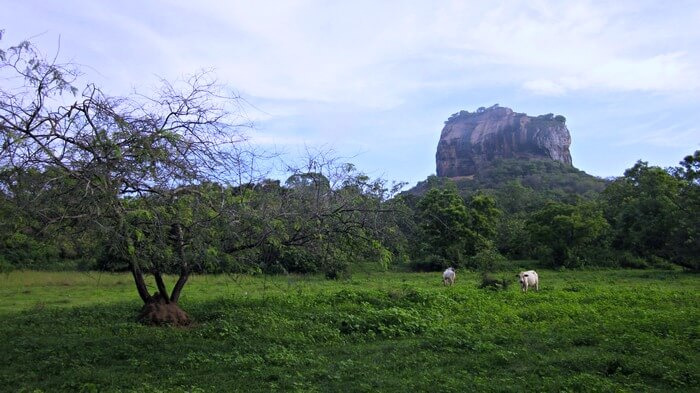
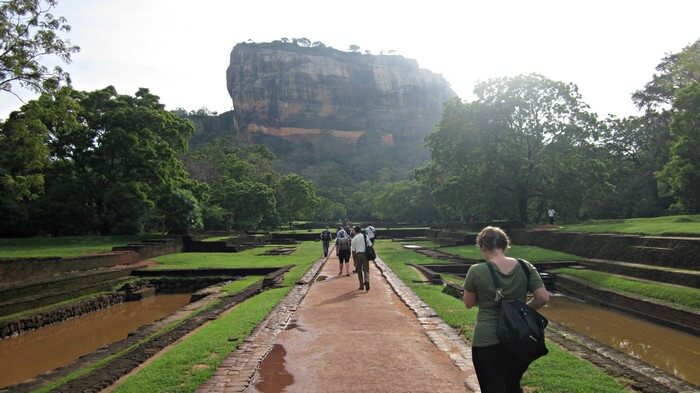
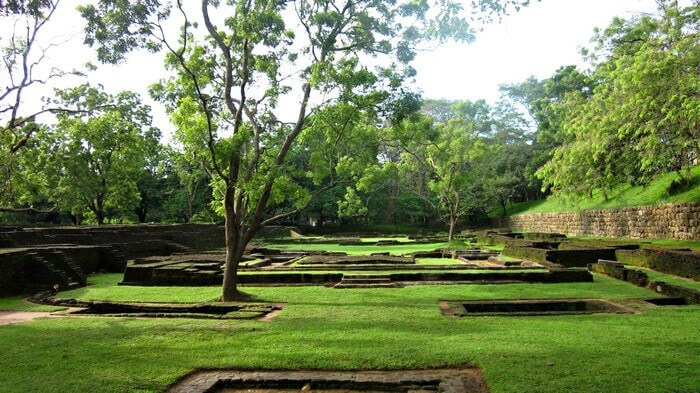
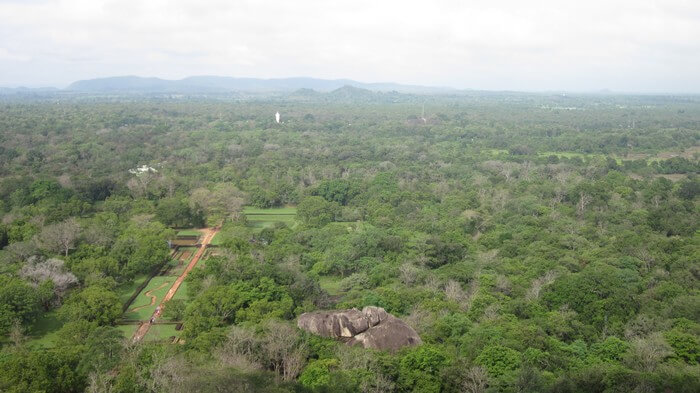
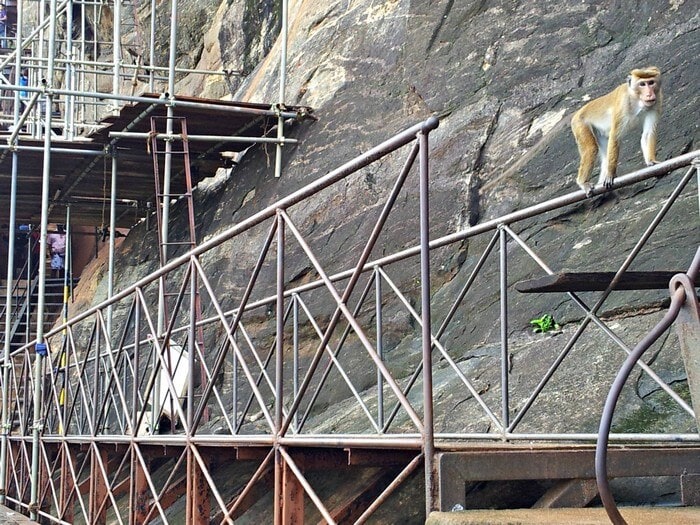
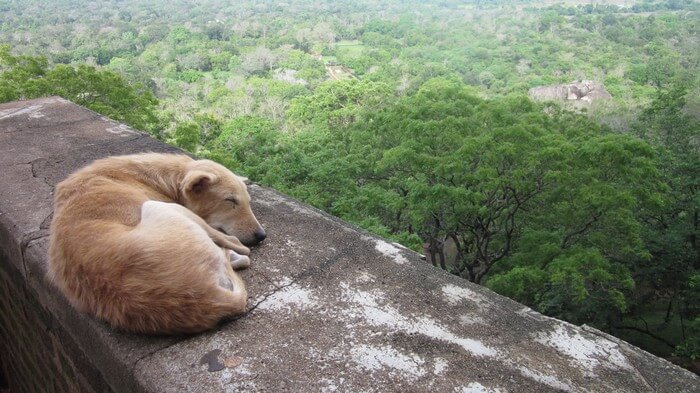
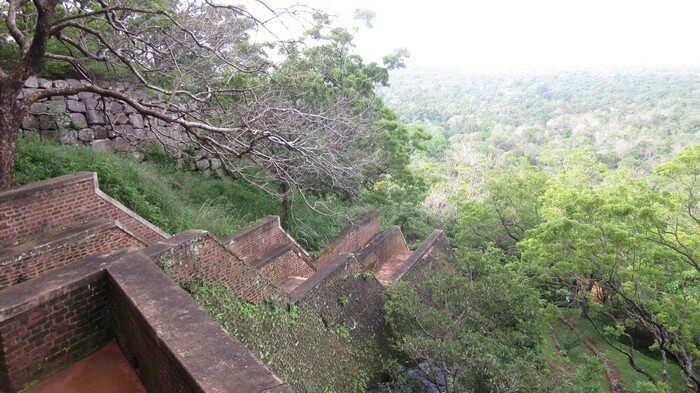
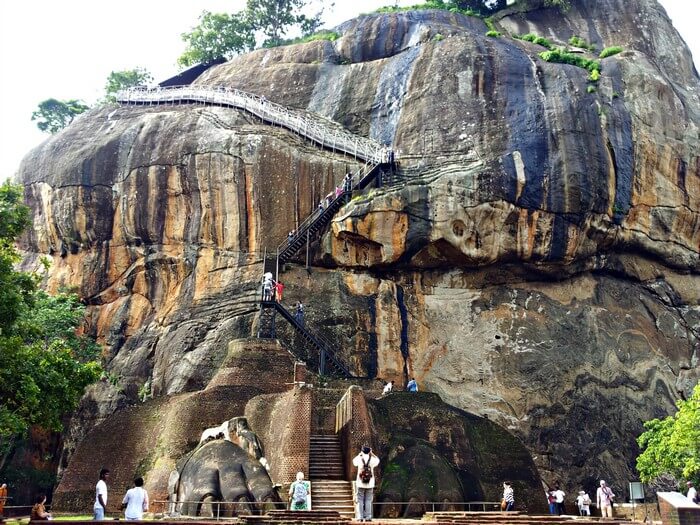
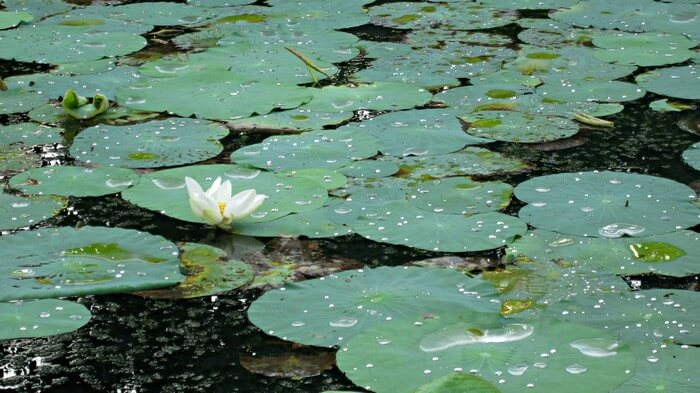
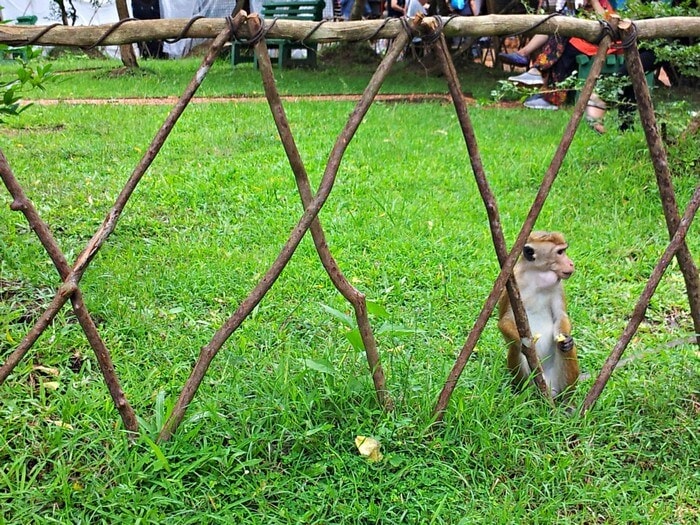
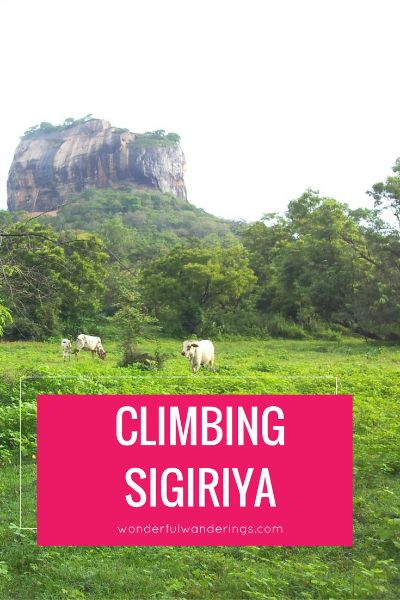
Laura @Travelocafe says
Thanks for sharing your visit and taking us along every step of the way. Great read. I love the video too.
nancy alexander says
Gelukkig ben ik niet de enigste die het eng vond. Ik heb ook enorme hoogtevrees en die doorkijktrappen vond ik zooooo eng. En dan moet je ook nog eens buitenom lopen…nog verder van de rotsrand af. Wat me er doorheen sleepte was het feit dat die trappen er al 100 jaar hangen…dus ja ik heb het uiteindelijk wel gered. Ik heb alleen niet heel erg van het uitzicht genoten…ik had een totale paniekaanval (want ik moest ook nog naar beneden…beh). Mijn moeder heeft uiteindelijk een fles water over me heen gekieperd om me weer rustig te krijgen en dat hielp gelukkig. Zo kon ik de laatste twee treden op die bovenop in het midden liggen en uitkijken over het omringende oerwoud.
Ondanks dat ik heeeeeeel hard roep nooooit weer wil ik wel sygaria heel erg graag aan mijn man laten zien. De frescoes en de mirror wall vond ik zo enorm indrukwekkend, daarvoor wil ik nog wel een stukje klimmen.
Sofie says
Jij vond het bemoedigend dat die trappen er al zolang hangen? :D Volgens mij zijn die metalen wel al eens vervangen, niet? Dat moet ik eens Googlen…
Wow seg, dat is wel heftig:/ Een echte paniekaanval heb ik nog nooit gehad. Daarvoor heb ik mezelf denk ik nog niet gepusht:/ Dat naar beneden gaan vind ik vaak nog enger dan naar boven!
De frescoes zou ik ooit misschien ook wel eens doen, maar naar helemaal boven… Brrrr. Als er heel weinig volk is misschien. Op zo’n momentel verdraag ik echt geen drukte rond me.
nancy alexander says
Ik probeerde het maar positief in te zien….en het was gelukkig helemaal niet deuk toen ik er was. Ik denk dat er nog geen tien mensen boven stonden, ikke, mijn moeder, onze reisgenote (sliep in dezelfde acco in kandy en we hadden gemeenschappelijk een chauffeur ingehuurd) en onze gids. Verder herriner ik me nog een stelletje en dat was het wel zo’n beetje.
En ach, mijn collegae op studiereis zijn niet verder gekomen dan de voet van de rots. Het stortregende zo hard die dag dat helemaal niemand naar boven kon. Moet ik ook niet aan denken om met onweer bovenop zo’n hoge rots boven alles uit te steken…brrr
Ik vind dat je best trots mag zijn op jezelf. Je hebt alsnog een heel stuk gedaan en het is gewoon heel erg eng. Zeker voor mensen met hoogtevrees.
Sofie says
How neen zeker niet in de regen!
Bedankt, nu voel ik me toch iets minder een watje ;-)
Rosalia says
Amazing post, thank you so much for sharing your experience. Very useful.
Sofie says
Thanks for commenting, Rosalia! I’m glad you liked it :-)
Molly says
Can you climb the rock for free if you choose not to go and explore the top (lion fortress) ???
Sofie says
I’m afraid not. The rock is part of the domain so you always have to pay an entry fee.
R. Jhon says
The climb is not worthit, tourisrs are charged 4500 rupees (40 USD) while locals are charged 50 rupees.
In my prospective this is a total rip-off not worth the money.
Sofie says
Do you consider the climb not worth it based on what they’re charging for it?
I thought it was worth it. Especially the view from above. We also had a guide so we got a lot of information on the way to the top.
As I mentioned, there are people who will try to rip you off with the tickets, but you can also do this as part of a larger tour.
It’s best to research the prices beforehand.
As to tourists being charged more than locals – I don’t know if that’s the case but if it were, I think I could understand it to a certain degree.